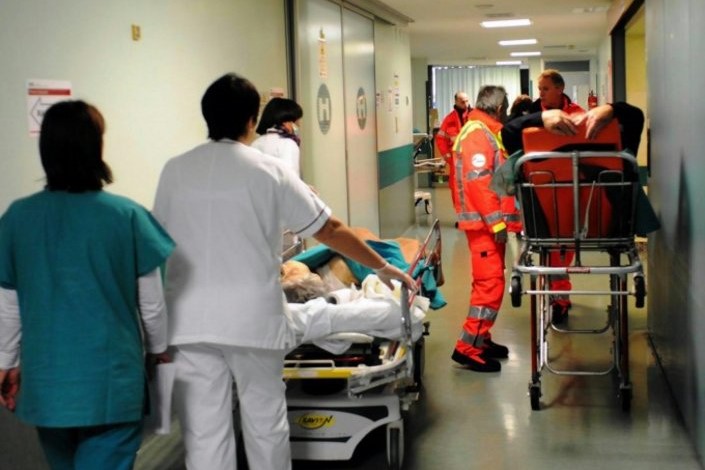
Italy, new colour codes for triage have come into force in emergency rooms
The new national guidelines for triage in emergency rooms are coming into force in the various Italian regions, and these days this has happened in Lombardy
Essentially, with this change in patient assessment, we go from four to five priority codes
Triage in the Emergency Department, the colour codes
Red – critical: interruption or impairment of one or more vital functions.
Orange – acute: vital functions at risk.
Blue – deferable urgent: stable condition with suffering. Requires in-depth diagnostics and complex specialist examinations.
Green – minor urgency: stable condition without evolutionary risk. Requires in-depth diagnostics and single-specialist visits.
White – non-urgent: non-urgent problem.
In the new colour code assignment, not only the level of criticality of the person arriving in the Emergency Department is assessed, but also the clinical-organisational complexity and the care commitment required to activate the care pathway.
The advantages of the new triage in the emergency department
This optimises the patient pathway and improves the patient experience.
Compared to the previous subdivision, in the new triage system the colour blue has been introduced to indicate a deferrable urgency, placed between orange (replacing yellow) and green.
In the discharge report, the colour is no longer indicated, but the priority definition: critical (emergency), acute (urgency), deferable urgency, minor urgency, non-urgent.
Read Also
Emergency Live Even More…Live: Download The New Free App Of Your Newspaper For IOS And Android
Code Black In The Emergency Room: What Does It Mean In Different Countries Of The World?
Emergency Room, Emergency And Acceptance Department, Red Room: Let’s Clarify
Ambulance Color Codings: For Function Or For Fashion?
Emergency Room Red Area: What Is It, What Is It For, When Is It Needed?
Calculating The Surface Area Of A Burn: The Rule Of 9 In Infants, Children And Adults
First Aid, Identifyng A Severe Burn
Fires, Smoke Inhalation And Burns: Symptoms, Signs, Rule Of Nine
Burns, How Bad Is The Patient? Evaluation With Wallace’s Rule Of Nine
Hypoxemia: Meaning, Values, Symptoms, Consequences, Risks, Treatment
Difference Between Hypoxaemia, Hypoxia, Anoxia And Anoxia
Occupational Diseases: Sick Building Syndrome, Air Conditioning Lung, Dehumidifier Fever
Obstructive Sleep Apnoea: Symptoms And Treatment For Obstructive Sleep Apnoea
Our respiratory system: a virtual tour inside our body
Tracheostomy during intubation in COVID-19 patients: a survey on current clinical practice
Chemical Burns: First Aid Treatment And Prevention Tips
Electrical Burn: First Aid Treatment And Prevention Tips
6 Facts About Burn Care That Trauma Nurses Should Know
Blast Injuries: How To Intervene On The Patient’s Trauma
What Should Be In A Paediatric First Aid Kit
Compensated, Decompensated And Irreversible Shock: What They Are And What They Determine
Burns, First Aid: How To Intervene, What To Do
First Aid, Treatment For Burns And Scalds
Wound Infections: What Causes Them, What Diseases They Are Associated With
Patrick Hardison, The Story Of A Transplanted Face On A Firefighter With Burns
Electric Shock First Aid And Treatment
Electrical Injuries: Electrocution Injuries
Emergency Burn Treatment: Rescuing A Burn Patient
Disaster Psychology: Meaning, Areas, Applications, Training
Medicine Of Major Emergencies And Disasters: Strategies, Logistics, Tools, Triage
Fires, Smoke Inhalation And Burns: Stages, Causes, Flash Over, Severity
Earthquake And Loss Of Control: Psychologist Explains The Psychological Risks Of An Earthquake
Civil Protection Mobile Column In Italy: What It Is And When It Is Activated
New York, Mount Sinai Researchers Publish Study On Liver Disease In World Trade Center Rescuers
PTSD: First responders find themselves into Daniel artworks
Firefighters, UK Study Confirms: Contaminants Increase The Likelihood Of Getting Cancer Fourfold
Civil Protection: What To Do During A Flood Or If A Inundation Is Imminent
Earthquake: The Difference Between Magnitude And Intensity
Earthquakes: The Difference Between The Richter Scale And The Mercalli Scale
Difference Between Earthquake, Aftershock, Foreshock And Mainshock
Major Emergencies And Panic Management: What To Do And What NOT To Do During And After An Earthquake
Earthquakes And Natural Disasters: What Do We Mean When We Talk About The ‘Triangle Of Life’?
Earthquake Bag, The Essential Emergency Kit In Case Of Disasters: VIDEO
Disaster Emergency Kit: how to realize it
Earthquake Bag : What To Include In Your Grab & Go Emergency Kit
How Unprepared Are You For An Earthquake?
Emergency preparedness for our pets
Difference Between Wave And Shaking Earthquake. Which Does More Damage?
ABC, ABCD And ABCDE Rule In Emergency Medicine: What The Rescuer Must Do
Evolution Of Pre-Hospital Emergency Rescue: Scoop And Run Versus Stay And Play
What Should Be In A Paediatric First Aid Kit
Does The Recovery Position In First Aid Actually Work?
Is Applying Or Removing A Cervical Collar Dangerous?
Cervical Collars : 1-Piece Or 2-Piece Device?
Cervical Collar In Trauma Patients In Emergency Medicine: When To Use It, Why It Is Important
KED Extrication Device For Trauma Extraction: What It Is And How To Use It
How Is Triage Carried Out In The Emergency Department? The START And CESIRA Methods
Basic Life Support (BTLS) And Advanced Life Support (ALS) To The Trauma Patient


